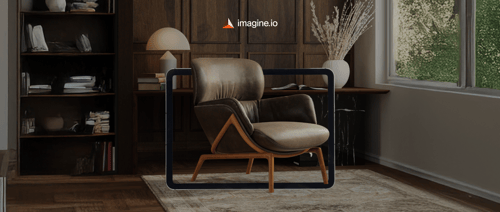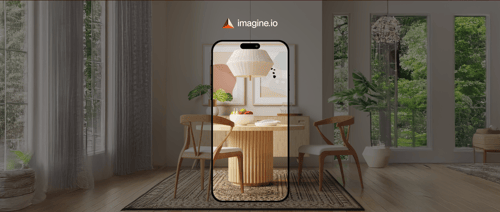Let’s face it—traditional product photography has reached its breaking point. If you’re a retailer or product manufacturer, you’ve likely felt the pain: endless photo shoots, tight timelines, inflated budgets, and logistics that feel more like military operations.
You wait days—or weeks—for perfect shots, only to realize you need to reshoot after a tiny spec change or packaging update. But there’s a smarter, faster, and far more scalable solution on the rise: digital twins.
And no, digital twins aren’t some sci-fi concept—they're already transforming retail pipelines from production to promotion.
Let’s unpack how they’re solving the photography bottleneck that’s been dragging retail marketing teams for years.
Get the latest updates straight to your inbox.
By clicking sign up you'll receive occasional emails from imagine.io. You always have the choice to unsubscribe within every email you receive.
Enter: Digital Twins
A digital twin is a hyper-realistic 3D model of a physical product. It’s not just a CAD file—it’s textured, photoreal, and virtually indistinguishable from a high-end product photo.
Once created, a digital twin can be used over and over again to generate:
- Static product shots
- Lifestyle scenes
- 360° product spins
- Augmented reality (AR) assets
- Custom variants on demand
All without ever lifting a camera again. And it’s not just a smart creative move—it’s a booming industry. The global digital twin market is projected to reach over $471 billion by 2034, driven largely by its adoption in retail, manufacturing, and ecommerce.
Real Results, Minus the Physical Hassle
Let’s say you’re launching a new line of furniture.
With traditional photography, you’d ship all your samples to a studio, coordinate a full set design, and photograph each SKU with every fabric or finish. That’s dozens of hours and tens of thousands of dollars.
Now, imagine this instead: You create one master digital twin of each item. Swap out wood tones or fabrics digitally. Drop your product into any room scene imaginable—modern, boho, industrial—without ever renting a location.
That’s exactly what platforms like imagine.io enable. You get the flexibility of a visual studio right in your browser. No cameras. No crews. No chaos.
Why Digital Twins Beat Traditional Photos (Almost Every Time)
Here’s how digital twins compare to the old way:
|
Feature |
Traditional Photography |
Digital Twins |
|
Speed |
Days to weeks |
Minutes to hours |
|
Cost |
High recurring costs |
One-time investment |
|
Scalability |
Limited to shoot scope |
Infinite variations |
|
Reusability |
Minimal |
Maximal |
|
Sustainability |
High waste (shipping, samples, props) |
Eco-friendly |
For B2B brands managing vast product catalogs or rapid seasonal turnover, this isn’t just a nice-to-have—it’s mission critical.
A B2B Game-Changer
Let’s shift lenses for a second. If you’re in product marketing, creative ops, or ecommerce management, your job depends on delivering assets fast and at scale. Digital twins let you:
- Launch campaigns early, even before samples arrive.
- Test market variations instantly (different colors, textures, packaging).
- Reduce reliance on physical samples, which are often delayed or expensive to produce.
- Keep creative teams nimble by centralizing assets in a digital ecosystem.
It’s not just about faster visuals—it’s about making product content creation as agile as your product development pipeline.
Final Thoughts: Rethink How You Create, Not Just What You Create
Here’s the thing—product visuals shouldn’t slow you down. Not in 2025. Not when everything else in retail is moving at the speed of AI, automation, and instant customer feedback.
Digital twins aren’t a workaround. They’re a better way to build.
They give you control over your content pipeline. They eliminate the guesswork, the reshoots, the wasted spend. And they make it possible to adapt faster—to changes in design, market trends, or even just Monday morning meetings.
And if you're wondering where to start, look at what platforms like imagine.io are doing. It’s not about replacing your creative team—it’s about giving them the right tools to keep up. Book a demo with our experts today to know more.


.gif?width=1296&height=1296&name=Untitled%20design%20(8).gif)



.png?width=500&name=How%20to%20Add%20a%203D%20Product%20Configurator%20to%20Your%20WordPress%20Website%20(Complete%20B2B%20Guide).png)
















%20(1).png?width=500&name=Why%20Exploded%20Mattress%20Views%20Matter%20(And%20How%20to%20Generate%20Them)%20(1).png)
.png?width=500&name=Best%20Shopify%20Product%20Configurator_%20How%20to%20Choose%20the%20Right%20One%20(2).png)
.png?width=500&name=Why%20Exploded%20Mattress%20Views%20Matter%20(And%20How%20to%20Generate%20Them).png)



.png?width=500&name=Best%20Shopify%20Product%20Configurator_%20How%20to%20Choose%20the%20Right%20One%20(1).png)







.png?width=500&name=How%203D%20Rendering%20Can%20Make%20or%20Break%20Your%20Industrial%20Design%20Pitch%20(1).png)








%20with%20Digital%20Twins%20and%203D%20Visualization.png?width=500&name=Optimizing%20Your%20Digital%20Asset%20Management%20(DAM)%20with%20Digital%20Twins%20and%203D%20Visualization.png)




.png?width=500&name=Styling%20Home%20Decor%20for%202025_%20From%20Global%20Influences%20to%20Playful%20Personalization%20(1).png)

